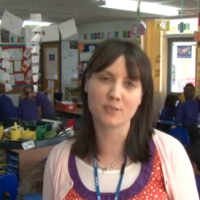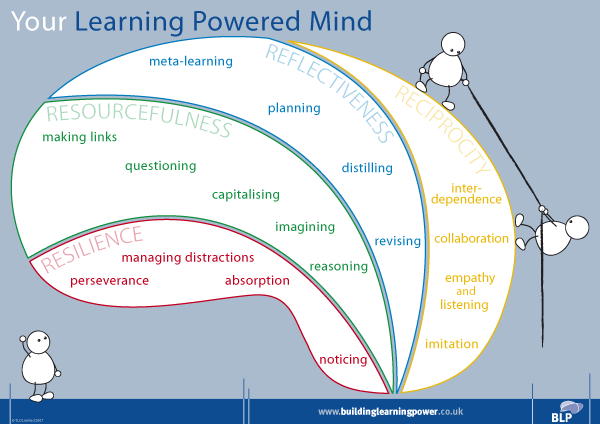BLP has a clear social, moral and philosophical rationale. It puts at the heart of education the development of psychological characteristics that are judged to be of the highest value to young people growing up in a turbulent and demanding world. And it has a robust scientific rationale for suggesting what some of these characteristics might be, and for the guiding assumption that these characteristics are indeed capable of being systematically developed.
Two BLP frameworks
Within this context, BLP provides two frameworks. The first is a coherent picture of what the powerful learner is like. The second is a route map of how schools can build the constituent dispositions of the powerful learner.
The first framework
The image of the powerful learner – doesn’t claim to be a comprehensive theory of learning power. Rather it aims to be a pragmatic tool that illustrates some of the ingredients of learning power and provides a basis for discussion. Many schools who have made use of this framework have developed and customised it in a host of creative ways.
This framework is essential, if teachers are going to think precisely and creatively about how they can become more effective ‘learning power coaches’. Using the analogy of a fitness coach in a gym such coaches are able to construct broad, balanced and effective exercise regimes that will help people get fitter, because they have a model of what the different ingredients are that go to make up ‘fitness’. BLP assumes that a working model of learning power helps teachers design targeted, effective activities that, over time, add up to greater confidence and capacity in facing all kinds of uncertainties and challenges. Just as fitness is a basic springboard for all kinds of more specific physical skills, so learning power is a general-purpose launch-pad for all kinds of more specific learning activities – both in school and out. So the first framework provides a design template for that launch-pad which schools can then extend in their own ways.
The second framework
The second framework maps the ingredients of a school and classroom culture that help to cultivate those habits of mind. If we want young people to become better at concentrating, say, what does that suggest about the way we structure our lessons? If we want them to become more willing to take risks in their learning, and more tolerant of making mistakes, how should we alter the way we mark their work, or the choices we make about what to display on the walls of the classrooms and corridors? If we want youngsters to become better at giving supportive feedback to each other, and at learning how to take such feedback without getting defensive – what does that suggest about how we might let them see more of us, the teachers, engaging in peer observation and discussion? And so on.

These two frameworks gives teachers and students a ‘big picture’ to hang on to, the picture on the box, as it were, to provide a context whilst they are working on one small corner of the learning power jigsaw puzzle. The first framework, which we called originally the Learning Power Brain, reminds everyone that they don’t have to work on exercising all the learning muscles at once (just as you don’t try to do your stretches while you are on the running machine). We can zoom in on ‘managing distractions’ knowing that, in due course, the big picture will remind us to work on building up ‘empathy’ or ‘reasoning’ as well.
The second framework, called the Teachers’ Palette, provides a complementary overview of all the different aspects of their work which teachers can use to build these learning muscles. There are many layers, we have discovered, through which a school can build up a culture that nurtures the development of inquisitiveness, responsibility and independence. This framework provides a basis for long-term planning. Some of the layers may be relatively easy for a teacher or a school to get to work on straightaway. With others it may take a bit of thought to see how the pupils (or the governors or the parents) will need to be ‘prepped’ in order to be ready to start taking the necessary steps.
Just as learning power is made up of a number of different interwoven elements, so is the school culture that cultivates learning power. As the image shows, there is good reason think that the way teachers talk is important, as is the visibility of their own learning habits. The design of activities, the structuring of space, the accessibility of resources, and the messages of the visual environment are all important too. And it is not just teachers who embody the principles of learning power: so too do learning support assistants, midday-supervisors, administrative staff, governors and parents. A learning powered school helps everyone to know how to add to the nutrient medium – the culture – in which its pupils are immersed.
Customised learning programmes to meet your needs
Building Learning Power™ is the still growing outcome of more than twelve years’ work, thinking and experience by Professor Guy Claxton, TLO Limited, and schools of all types.



[…] of: their school values, the Tātaiako cultural competencies, the key competencies of the NZC, Guy Claxton’s learning muscles, and in the case of a Catholic school, their missionaries framework. This was a valuable […]